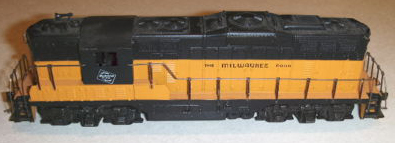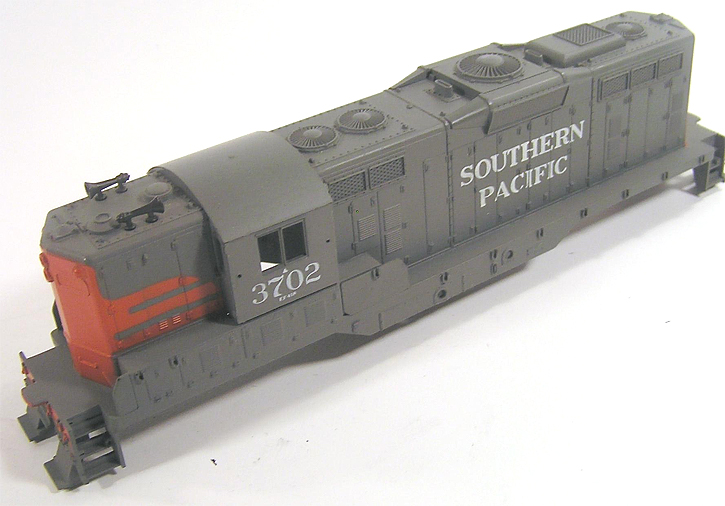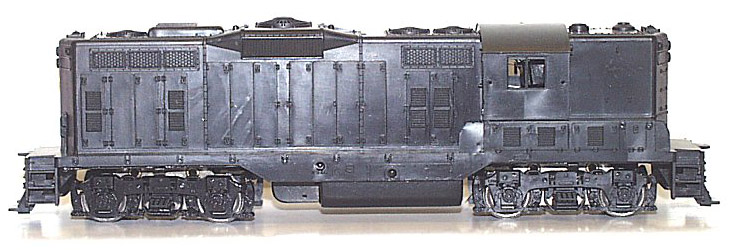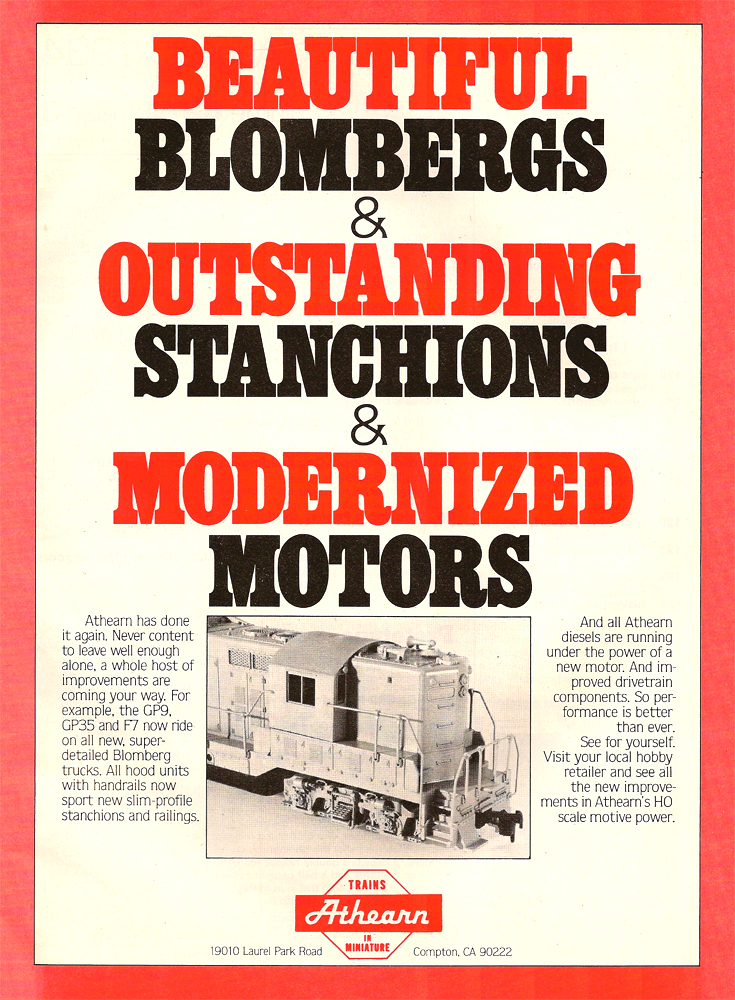|

EMD GP9
Baltimore & Ohio
No.3152 -Powered
No.3052 -Dummy

EMD GP9
Burlington
No.3155 -Powered
No.3055 -Dummy

EMD GP9
Great Northern
No. 3157 -Powered
No. 3057 -Dummy

EMD GP9
Milwaukee Road
No.3159 -Powered
No.3059 -Dummy


EMD GP9
Santa Fe -Blue and Yellow
No. 3156 -Powered ATSF #2685 -1961 Release
No. A3156 -Geared RTR ATSF #2685
No. 3056 -Dummy ATSF #2685 -1962 Release
No. 3156 -Powered ATSF #8517 -1996 Release

EMD GP9
Santa Fe - Zebra Stripe
No. 1056 -Dummy Kit ATSF #2685
No. 1156 -Powered w/Hi-F Drive ATSF #2685 -1957 Release
No. 2156 -Powered w/Hi-F Drive RTR ATSF #2685
There are variations to the application of striping on Athearn's Zebra Stripe Santa Fe GP9,
but all to my knowledge carry roadnumber 2685.

EMD GP9
Southern Pacific
No.3153 -Powered
No.3053 -Dummy

EMD GP9
Union Pacific
No. 3154 -Powered
No. 3054 -Dummy

EMD GP9
Wabash
No. 1158 -Powered HI-F Kit
No. 2158 -Ready To Run
No. 1058 -Dummy Kit

EMD GP9
Undecorated
No.3151 -Powered
No.3051 -Dummy
The GP9 followed the introduction of Athearn's F7s. The GP9 first appeared in 1957. Though
second in the compnay's line of diesels, or third if you give the F7-B proper credit, the GP9 is actually the first diesel
tooled by Athearn. The F7 arrives from Globe Models and is reported by Dallas Mallerich in his "Greenberg's Guide to Athearn
Trains," to have been a Silver Streak project originally. Either way, Globe or Silver Streak, the F7 tooling was purchased
by Athearn and not their own development as the GP9 was from design to introduction.
 The Athearn model's pair of louvers below the radiator grilles at the rear end of the long hood would make this a GP7. I
have heard that early spotters split the geeps between GP7 and GP9 by the inclusion of a dynamic brake. This may be a contributing
factor to Athearn's labeling this model a GP9 and not correctly as a GP7. It is interesting that as the model was cloned
by others over the years, all retained the incorrect usage of GP9, rather than calling it a GP7. Athearn, as done with the
SW1500-SW7, did begin calling this model a GP7. This change to its rightful model name happens for the geep's 40th birthday
in the Athearn line in 1998. As my site does not extend into this modern era of Athearn, I will refer to this model as a
GP9 to match Athearn's usage. The B&O example illustrated is sitting in an Athearn package that was used for a short time
in the early 1960s. The GP9 would be featured on the lid of this box in SP Black Widow. The GP9 may also be found on box
lid with UP decorated examples. Both examples are limited in Athearn's use and date to the early '60s.
The Athearn model's pair of louvers below the radiator grilles at the rear end of the long hood would make this a GP7. I
have heard that early spotters split the geeps between GP7 and GP9 by the inclusion of a dynamic brake. This may be a contributing
factor to Athearn's labeling this model a GP9 and not correctly as a GP7. It is interesting that as the model was cloned
by others over the years, all retained the incorrect usage of GP9, rather than calling it a GP7. Athearn, as done with the
SW1500-SW7, did begin calling this model a GP7. This change to its rightful model name happens for the geep's 40th birthday
in the Athearn line in 1998. As my site does not extend into this modern era of Athearn, I will refer to this model as a
GP9 to match Athearn's usage. The B&O example illustrated is sitting in an Athearn package that was used for a short time
in the early 1960s. The GP9 would be featured on the lid of this box in SP Black Widow. The GP9 may also be found on box
lid with UP decorated examples. Both examples are limited in Athearn's use and date to the early '60s.
Five roadnames were included in Athearn's original GP9 release of 1957: B&O, Burlington, Santa Fe, Southern Pacific, and
UP. These early GP9 offerings decoration differ from later production runs, most notably the CB&Q is black and not Chinese
red, the Santa Fe features the road's Zebra black scheme and not the later blue and yellow bookends, and the SP is first in
Black Widow dress with the bloody nose red and gray replacing it some years later. The May 1957 Model Railroader reviews
the new GP9, "Athearn offers versatile HO GP-9 with rubber band or gear drive."
Great Northern, Wabash, and Milwaukee Road are present by the 1959-60 catalog with the Milwaukee GP9 featured in illustration
on the cover of this annual publication. By 1962, Athearn's catalog illlustrations show the red CB&Q GP9 and blue and yellow
ATSF example. Spotting features of these early examples include separate sections on both side of the long hood that make
up the dynamic brake blisters. I frequent see these add-on brake blisters in kits in plain black plastic.

Great Northern, Wabash, and Milwaukee Road are present by the 1959-60 catalog with the Milwaukee
GP9 featured in illustration on the cover of this annual publication. By 1962, Athearn's catalog illlustrations show the red
CB&Q GP9 and blue and yellow ATSF example. Spotting features of these early examples include separate sections on both side
of the long hood that make up the dynamic brake blisters. I frequent see these add-on brake blisters in kits in plain black
plastic. While dynamic brakes and the outer coverings of the steps around the cab areas were often left in raw plastic, early
practice was to paint the radiator and dynamic brake fans to match one of the body colors. In the illustration here, you'll
see the Milwaukee Road GP9 features orange fans. The UP example has black for fans and brake blister. The Union Pacific
pictured here has a pair of horns on the short hood roof, early examples included side mounted brass horns. You'll see an
example of the brass horns in the Wabash entry above.
|

Here's an example of the printing found on many early HO-scale models. It is interesting to
compare this Santa Fe billboard lettering found on an early fully assembled Athearn GP9 to today's efforts. Notice the Santa
Fe lettering is not exactly the Cooper typeface. Also, the lettering begins to become blurred and fuzzy as you go left to
right across the name. Technology and technique have greatly improved the quality of models found today. Our sample also
rides on a cast metal frame and metal trucks, a sign of earlier Athearn days.

Athearn supplied product to Lionel for its HO-scale offerings in 1958. Lionel would make its
own items as the HO line survived into the '60s. Above is an example of Lionel's own tooling for their HO-scale GP9. While
not an Athearn creation, one sees the influence or inspiration of the Athearn model in the Lionel tooling. Lionel's GP9 does
differ in many respects from the Athearn and is easy to spot compared to the Athearn GP9. The Lionel includes a higher curved
roofline, as compared to the Athearn. Lionel also included a molded-in horizontal nameplate of sorts on the unit's long hood
that is not present on the Athearn. In the above Santa Fe example, the long hood nameplate is painted as a yellow band below
the railroad's name. Beyond the shell's differences, the Lionel-made GP9 rides on a drive/underframe much different from
Athearn examples.
Athearn did supply Milwaukee Road and Wabash GP9 diesels to Lionel for a short time. The two-color Milwaukee and tri-color
Wabash were similar to counterparts in Athearn's line, however the Lionel examples both included the circled "L" logo.
 In 1974, Lionel returned to HO-scale and resurrected pieces from its previous line. The GP9 returns in 1974, but it is a
revised tooling that more closely resembles the Athearn model than the '60s effort from Lionel. The final year for Lionel-HO's
'70s line is 1977. The Lionel second tooling GP9 has not resurfaced since the company's withdrawl from HO a second time.
On display here is a blank and red CN example, exclusive to the Canadian market, that included a Kader-made drive from Hong
Kong.
In 1974, Lionel returned to HO-scale and resurrected pieces from its previous line. The GP9 returns in 1974, but it is a
revised tooling that more closely resembles the Athearn model than the '60s effort from Lionel. The final year for Lionel-HO's
'70s line is 1977. The Lionel second tooling GP9 has not resurfaced since the company's withdrawl from HO a second time.
On display here is a blank and red CN example, exclusive to the Canadian market, that included a Kader-made drive from Hong
Kong.

Cox included a chop-nose GP9 in its catalog beginning with its switch to Hong Kong-produced models
in 1975. Seen here are four Cox GP9 examples dressed for Santa Fe, Rock Island, Chessie, and the fictious Championship Train.
Athearn had been making the Cox HO-scale model train line since 1971 populating it with items from Athearn's line, though
the GP9 was never sold as a Cox model. An inspection of the Cox GP9 model would strongly suggest the Athearn GP9 was the
inspiration for much of the tooling. Cox left the HO-scale train market in 1978. Today, Walthers sells a GP9 which is based
on the Cox tooling. Another close relative is the Model Power GP9, which appears to have had the Cox model as its inspiration.

This August
'84 ad details the improvements that hit the Athearn line with new drives; new tooling plastic trucks; and better detailed
stanchions. These modifications covered Athearn's GP9; GP35; and F7 models produced from this point forward. Though the
narrow drive would enable Athearn to produce scale-width hoods on 1980s EMD releases like the GP38-2, GP50, and SD40-2, the
GP9 would not trim its wide body and remained too wide for the duration of its life with Athearn. The model is no longer
part of the company's offerings. A new GP7/GP9 was displayed in 2010 by Athearn further sealing the fate of this classic
blue box model.
|

